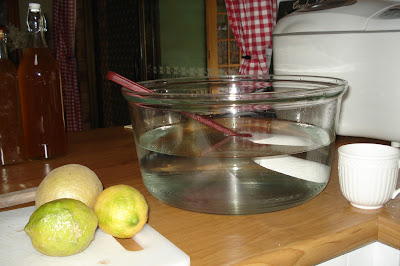Hanno and I had the first drink from the latest batch of ginger beer last night. It was so good! I sent a bottle of it down to Kerry and Sunny too so I'm spreading the love around. Ginger beer is a fermented drink that is easily made at home and as it's fermented, it contains many nutritious enzymes. In days gone by fermented food and drinks were part of our normal diet but we've lost the taste for them because commerce and convenience require that food and drinks are produced fast. My ginger beer takes about two weeks fermenting before it's ready to drink - this is traditional food, it's slow.

Isn't this bowl magnificent! It's a recycled bowl from one of those turbo ovens. One of the ladies at work brought it in because her oven died, but I gladly received the bowl and have given it a second life as my fermenting bowl.
Fermenting is a chemical process that, in this drink, uses beneficial bacteria to create lactic acid and converts the sugar in the drink into carbon dioxide. We've all been taught that bacteria and food don't mix but this beneficial bacteria is the same as that in yoghurt, kimchee, sauerkraut, kefir and sour dough. It's good stuff!
To make ginger beer you need only a few ingredients - ginger, sugar and water. All your utensils must be thoroughly clean as any bad bacteria or yeasts will ruin it and you'll have to throw the whole lot out. You'll need a wide mouthed jar or canning jar; a loose weave cover - such as this milk jug cover in my photo (we'll be making another one of these next week) a piece of muslin or cheesecloth to use as a strainer; a large mixing bowl capable of holding 4½ litres/quarts; several large plastic bottles; a large jug and a funnel.
MAKING THE CULTURE
Add one dessert spoon of ginger powder OR a tablespoon full of diced fresh ginger to the jar
Add one dessert spoon of sugar
To that add 1½ cups of rain water, filtered water or tap water that has been allowed to stand for 24 hours, and mix together.
During the day let this mixture sit on the kitchen bench with the cover off. Cover it at night. Every day for seven days add one dessert spoon of ginger powder OR a tablespoon full of diced fresh ginger to the jar, and one dessert spoon of sugar, and mix it in.
After a couple of days, depending on the temperature in your home (it's faster when it's warm) you'll notice little bubbles start to form. That is good, the fermentation has begun. Smell the mix, it should smell of ginger and towards the end of the process, it might smell slightly of alcohol. That's fine too, the amount of alcohol that might form is tiny and it will be diluted. It will develop a little alcohol if their are those wild yeasts in the air in your home. It's nothing to worry about, even if children will drink this.
On the seventh day, feed the culture, mix it, then strain through some muslin or cheesecloth into your large container. Then add 20 cups of water, 3 cups of white or raw sugar and the juice of two lemons. Mix well and then bottle using the funnel and jug. Don't fill the bottles completely because they need space for the gasses that will develop, so leave about two or three inches at the top.
After the ginger beer has been bottled it needs to ferment some more in the bottle. Let the bottles sit on your kitchen bench or in the pantry for a few days. If you notice some of the bottles puffing up, put them in the fridge straight away. When they're cool, they're ready to drink. In this last batch I made, one bottle matured faster than the others and I noticed it because the carbon dioxide in the bottle puffed out the bottom of the bottle and it fell over. The bottles should be fine the first two days but after that check them twice a day, you'll be able to see little bubbles forming when they're ready to go in the fridge. Don't use glass bottles because they can't expand and might explode.

Don't throw the dregs of the culture out. Like other live cultures it can be used again to start up your next batch. Just add it to your jar and start feeding it as usual.
It sound s bit scary but if you're careful and watch the bottles, you'll be fine. This is live food! It's dynamic, it changes all the time. But using plastic bottles and keeping an eye on the process will give you some fine healthy fizzy drinks that even the kids will like.
ADDITIONAL READING - An interesting article about fermented drinks from the Weston Price Foundation, and right at the end, the recipe for ginger beer.





